Polymer-Bonded/Bolted Steel Plates Versus UHPFRC Overlay for Controlling Deflection in RC Shallow Beams with Planted Columns—Experimental Insights
Abstract
1. Introduction
2. Testing Framework
2.1. Experimental Matrix
2.2. Materials Properties
2.3. Specimen Preparation
2.4. Instrumentation and Testing
3. Discussion of Experimental Findings
3.1. Failure Pattern and Peak Load
3.2. Load–Deflection Behavior
3.3. Load–Strain Characteristics
3.4. Comparative Assessment of Strengthening Systems
4. Analytical Investigation
Discussion of Analytical Results
5. Conclusions
- The common flexural failure mode of tension-controlled beams was present in both the control and retrofitted specimens. It involved the development of the main vertical cracks in the middle of the span, the tension bars’ yielding, and the concrete’s ultimate crushing on the compression side next to the planted column.
- The two strengthening schemes, steel plates and UHPFRC layer, proved highly efficient in upgrading the flexural response of shallow beams. Both methods significantly improved strength and stiffness while reducing total deflection to within serviceability limits prescribed by current design codes.
- Both the steel plate and UHPFRC overlay techniques proved highly effective, yielding comparable and substantial enhancements relative to the deficient control beam. Compared with the control specimen (CON-AB), both strengthening systems markedly increased the maximum load capacity, flexural stiffness, displacement ductility, and energy dissipation. Moreover, both upgraded beams successfully satisfied the serviceability (deflection) criteria, exhibiting superior performance to the code-compliant reference beam (CON-ACI).
- The analytical models developed in this study provided reasonably accurate predictions for the structural performance of both control and strengthened RC wide beam specimens. The errors in computing the maximum load were within 7%, for secant stiffness within 9%, and for total deflection within 8%. Moreover, for the immediate deflection, a strong correlation was observed between the predicted and experimentally measured load–deflection curves, further confirming the reliability of the developed models in accurately representing both the flexural behavior and serviceability performance of the tested beams.
- The findings of current research are limited to the case of simply supported RC wide beams and cannot be extended to continuous RC shallow beams. Also, the strengthening systems used in this study are added to the top surface of the RC wide beam. In cases where the top side of the beam is inaccessible, these techniques may not be feasible, and other upgrading techniques that may be added on the tension side could be more relevant.
- Compared with the authors’ earlier work on tension-side strengthening, which improved stiffness but caused brittle debonding and reduced ductility, the present compression-side schemes markedly enhanced strength, stiffness, and displacement ductility. Therefore, compression-side strengthening is recommended for effective deflection control in RC shallow beams with planted columns. Future studies should explore alternative systems for cases where the compression face is inaccessible to ensure ductile performance without debonding failures.
- A main limitation of this study is that only one specimen was tested for each configuration, which prevents statistical assessment of variability. Although the observed responses are consistent with established trends, the limited sample size constrains the generality of the findings. Future work should include replicates and parametric variations to enhance statistical reliability. Moreover, incorporating full-scale testing or finite element modeling would complement the experimental results and allow a broader parametric exploration of RC shallow beams strengthened in flexure using steel plates or UHPFRC overlay added on the compression side.
Author Contributions
Funding
Institutional Review Board Statement
Data Availability Statement
Acknowledgments
Conflicts of Interest
References
- Al-Negheimish, A.I.; El-Sayed, A.K.; Al-Zaid, R.A.; Shuraim, A.B.; Alhozaimy, A.M. Behavior of wide shallow RC beams strengthened with CFRP reinforcement. J. Compos. Constr. 2012, 16, 418–429. [Google Scholar] [CrossRef]
- Conforti, A.; Minelli, F.; Plizzari, G.A. Wide-shallow beams with and without steel fibres: A peculiar behaviour in shear and flexure. Compos. Part B Eng. 2013, 51, 282–290. [Google Scholar] [CrossRef]
- Ibrahim, A.; Askar, H. Dynamic analysis of a multistory frame RC building with and without floating columns. Am. J. Civ. Eng. 2021, 9, 177. [Google Scholar] [CrossRef]
- Jumaat, M.Z.; Alam, M.A. Problems associated with plate bonding methods of strengthening reinforced concrete beams. J. Appl. Sci. Res. 2006, 2, 703–708. [Google Scholar]
- Olajumoke, A.M.; Dundu, M. Methods for flexural strengthening of reinforced concrete elements using steel plates. In Construction Materials and Structures; IOS Press: Amsterdam, The Netherlands, 2014; pp. 1080–1085. [Google Scholar] [CrossRef]
- El-Sayed, A.K.; Al-Zaid, R.A.; Al-Negheimish, A.I.; Shuraim, A.B.; Alhozaimy, A.M. Long-term behavior of wide shallow RC beams strengthened with externally bonded CFRP plates. Constr. Build. Mater. 2014, 51, 473–483. [Google Scholar] [CrossRef]
- Alfeehan, A.A. Strengthening of RC beams by external steel plate using mechanical connection technique. J. Eng. Sustain. Dev. 2014, 18, 202–215. [Google Scholar]
- Aykac, S.; Kalkan, I.; Aykac, B.; Karahan, S.; Kayar, S. Strengthening and repair of reinforced concrete beams using external steel plates. J. Struct. Eng. 2013, 139, 929–939. [Google Scholar] [CrossRef]
- Al-Hassani, H.M.; Al-Ta’an, S.A.A.; Mohammed, A.A. Behavior of damaged reinforced concrete beams strengthened with externally bonded steel plate. Tikrit J. Eng. Sci. 2013, 20, 48–59. [Google Scholar] [CrossRef]
- Shin, Y.S.; Hong, G.H. Flexural Behavior of RC Beams Strengthened with Steel Plates/Carbon Fiber Sheets (CFS) under Pre-Loading Conditions. KCI Concr. J. 2000, 12, 69–77. [Google Scholar]
- Lotfy, E.M. Flexural strengthening of RC Beams. Int. J. Eng. Tech. Res. 2016, 6, 83–86. [Google Scholar]
- Sompornjaroensuk, Y. Flexure of Reinforced Concrete Beams Externally Strengthened by Epoxy Bonded Steel Plates with Anchored Bolts. Eng. Trans. A Res. Publ. Mahanakorn Univ. Technol. 2023, 26, 1–12. [Google Scholar]
- Jumaat, M.Z.; Alam, M.A. Strengthening of RC beams using externally bonded plates and anchorages. Aust. J. Basic Appl. Sci. 2009, 3, 2207–2211. [Google Scholar]
- Osman, R.; Elkhouly, A.; Eltaly, B.; Zakaria, M.H. Flexural Strengthening of Reinforced Concrete Beams with Substandard Tension Lap Splices Using a Novel Pre-stressing Technique. Int. J. Concr. Struct. Mater. 2025, 19, 45. [Google Scholar] [CrossRef]
- Lin, Y.; Wei, Y.; Gong, Z.; Xu, W.; Zhao, K. Flexural behavior of an RC beam externally strengthened with a steel- and CFRP-based method. Appl. Sci. 2024, 14, 9281. [Google Scholar] [CrossRef]
- Alasadi, S.; Ibrahim, Z.; Shafigh, P.; Javanmardi, A.; Nouri, K. An experimental and numerical study on the flexural performance of over-reinforced concrete beam strengthening with bolted-compression steel plates: Part II. Appl. Sci. 2019, 10, 94. [Google Scholar] [CrossRef]
- Alasadi, S.; Shafigh, P.; Ibrahim, Z. Experimental study on the flexural behavior of over reinforced concrete beams bolted with compression steel plate: Part I. Appl. Sci. 2020, 10, 822. [Google Scholar] [CrossRef]
- Zhu, Y.; Zhang, Y.; Hussein, H.H.; Chen, G. Flexural strengthening of reinforced concrete beams or slabs using ultra-high performance concrete (UHPC): A state of the art review. Eng. Struct. 2020, 205, 110035. [Google Scholar] [CrossRef]
- Abbas, S.M.L.N.; Nehdi, M.L.; Saleem, M.A. Ultra-high performance concrete: Mechanical performance, durability, sustainability and implementation challenges. Int. J. Concr. Struct. Mater. 2016, 10, 271–295. [Google Scholar] [CrossRef]
- Ullah, R.; Qiang, Y.; Ahmad, J.; Vatin, N.I.; El-Shorbagy, M.A. Ultra-high-performance concrete (UHPC): A state-of-the-art review. Materials 2022, 15, 4131. [Google Scholar] [CrossRef]
- Gao, X.L.; Wu, K.; Guo, Y.Q.; Zhao, Y.C.; Guo, J.Y. Experimental and numerical study on flexural behaviors of damaged RC beams strengthened with UHPC layer using the bonding technology of post-installed reinforcing bar. Constr. Build. Mater. 2023, 391, 131835. [Google Scholar] [CrossRef]
- Ahmed, F.B.; Biswas, R.K.; Sen, D.; Tasnim, S. Flexural and Shear Strengthening of Reinforced-Concrete Beams with Ultra-High-Performance Concrete (UHPC). Constr. Mater. 2024, 4, 468–492. [Google Scholar] [CrossRef]
- Paschalis, S.A.; Lampropoulos, A.P.; Tsioulou, O. Experimental and numerical study of the performance of ultra high performance fiber reinforced concrete for the flexural strengthening of full scale reinforced concrete members. Constr. Build. Mater. 2018, 186, 351–366. [Google Scholar] [CrossRef]
- Elsanadedy, H.M.; Abbas, H.; Almusallam, T.H.; Al-Salloum, Y.A. Hybrid UHPC/NSM CFRP strips vs. traditional systems for flexural upgrading of RC beams–Experimental and FE study. Compos. Struct. 2021, 261, 113291. [Google Scholar] [CrossRef]
- Yin, H.; Teo, W.; Shirai, K. Experimental investigation on the behaviour of reinforced concrete slabs strengthened with ultra-high performance concrete. Constr. Build. Mater. 2017, 155, 463–474. [Google Scholar] [CrossRef]
- Zhang, Y.; Li, X.; Zhu, Y.; Shao, X. Experimental study on flexural behavior of damaged reinforced concrete (RC) beam strengthened by toughness-improved ultra-high performance concrete (UHPC) layer. Compos. Part. B Eng. 2020, 186, 107834. [Google Scholar] [CrossRef]
- Mirdan, D.; Saleh, A.R. Flexural performance of reinforced concrete (RC) beam strengthened by UHPC layer. Case Stud. Constr. Mater. 2022, 17, e01655. [Google Scholar] [CrossRef]
- Tanarslan, H.M.; Alver, N.İ.N.E.L.; Jahangiri, R.; Yalçınkaya, Ç.; Yazıcı, H. Flexural strengthening of RC beams using UHPFRC laminates: Bonding techniques and rebar addition. Constr. Build. Mater. 2017, 155, 45–55. [Google Scholar] [CrossRef]
- Tanarslan, H.M. Flexural strengthening of RC beams with prefabricated ultra high performance fibre reinforced concrete laminates. Eng. Struct. 2017, 151, 337–348. [Google Scholar] [CrossRef]
- Murthy, A.R.; Karihaloo, B.L.; Rani, P.V.; Priya, D.S. Fatigue behaviour of damaged RC beams strengthened with ultra high performance fibre reinforced concrete. Int. J. Fatigue 2018, 116, 659–668. [Google Scholar] [CrossRef]
- Habel, K.; Denarié, E.; Brühwiler, E. Structural response of elements combining ultrahigh-performance fiber-reinforced concretes and reinforced concrete. J. Struct. Eng. 2006, 132, 1793–1800. [Google Scholar] [CrossRef]
- Huang, Y.; Grünewald, S.; Schlangen, E.; Luković, M. Strengthening of concrete structures with ultra high performance fiber reinforced concrete (UHPFRC): A critical review. Constr. Build. Mater. 2022, 336, 127398. [Google Scholar] [CrossRef]
- Ammar, W.; Kim, Y.J.; Ha, T. Strengthening of RC beams with UHPFRC incorporating GFRP rebars. In Proceedings of the Bridge Engineering Institute Conference 2024 (BEI-2024), Las Vegas, NV, USA, 22–25 July 2024; Available online: https://www.researchgate.net/publication/383280012 (accessed on 10 November 2025).
- Baatiah, A.; Elsanadedy, H.; Abadel, A.; Abbas, H.; Almusallam, T.; Al-Salloum, Y. Deflection Control of Concrete Wide Beams Supporting Columns Using CFRP Composites and Honeycomb Plates. Polymers 2025, 17, 2560. [Google Scholar] [CrossRef] [PubMed]
- ACI Committee 318. Building Code Requirements for Structural Concrete and Commentary (ACI 318-19); American Concrete Institute: Detroit, MI, USA, 2019. [Google Scholar] [CrossRef]
- Saudi Building Code National Committee (SBCNC). Saudi Building Code 304: Structural Requirements, 200923 ed.; Saudi Building Code National Committee: Riyadh, Saudi Arabia, 2018. [Google Scholar]
- ASTM C39/C39M-21; Standard Test Method for Compressive Strength of Cylindrical Concrete Specimens. ASTM International: West Conshohocken, PA, USA, 2021. [CrossRef]
- ASTM E8/E8M-16A; Standard Test Methods for Tension Testing of Metallic Materials. ASTM International: West Conshohocken, PA, USA, 2016. [CrossRef]
- ASTM C78/C78M-21; Standard Test Method for Flexural Strength of Concrete (Using Simple Beam with Third-Point Loading). ASTM International: West Conshohocken, PA, USA, 2021. [CrossRef]
- Mander, J.B.; Priestley, M.J.; Park, R. Theoretical stress-strain model for confined concrete. J. Struct. Eng. 1988, 114, 1804–1826. [Google Scholar] [CrossRef]
- Naeimi, N.; Moustafa, M.A. Analytical stress–strain model for steel spirals-confined UHPC. Compos. Part. C Open Access 2021, 5, 100130. [Google Scholar] [CrossRef]
- ACI Committee. Deflections of Reinforced Concrete Flexural Members, ACI 435-95; Reapproved 2000, with Appendix B Added in 2003; American Concrete Institute: Farmington Hills, MI, USA, 2003. [Google Scholar]
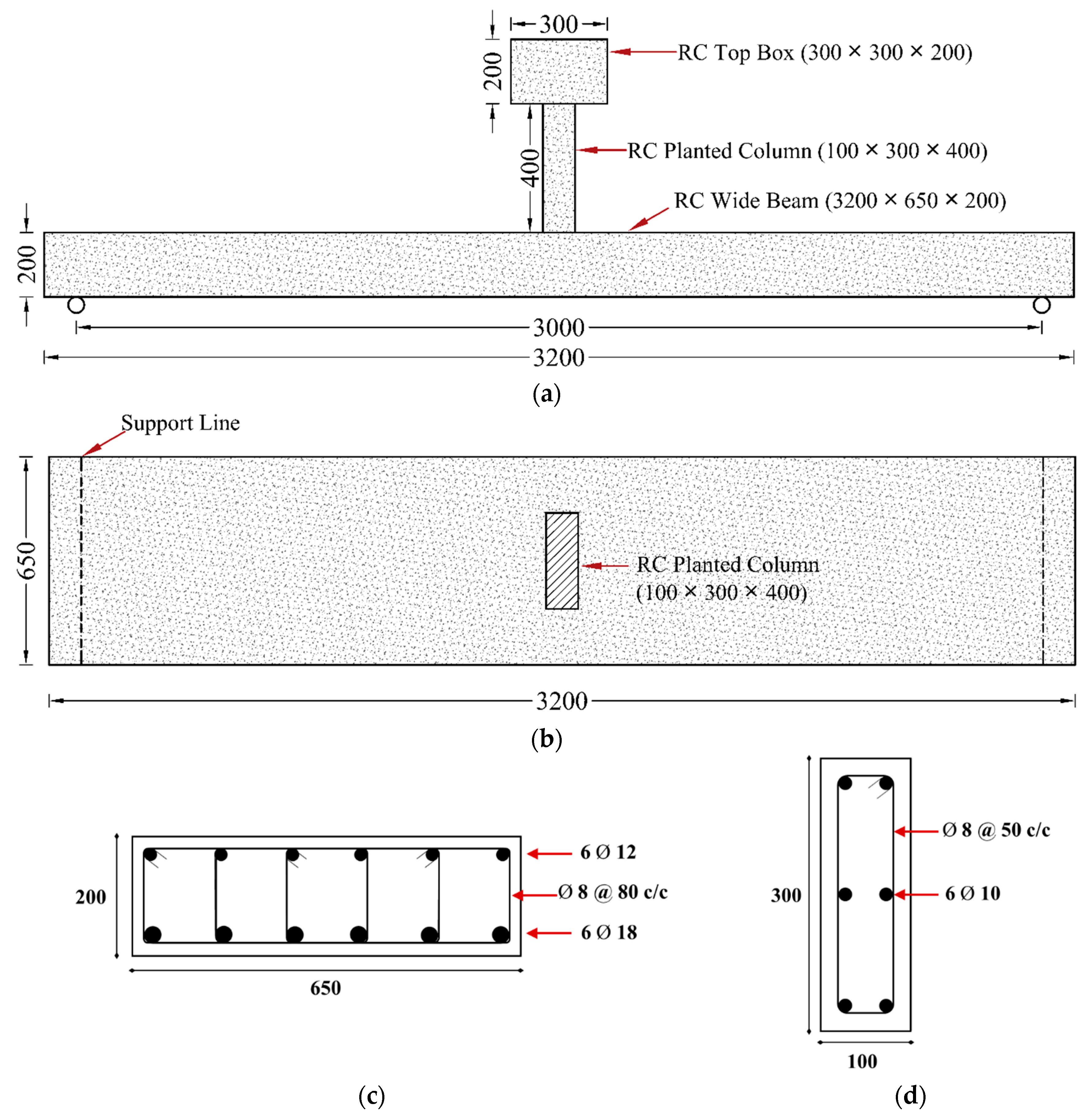


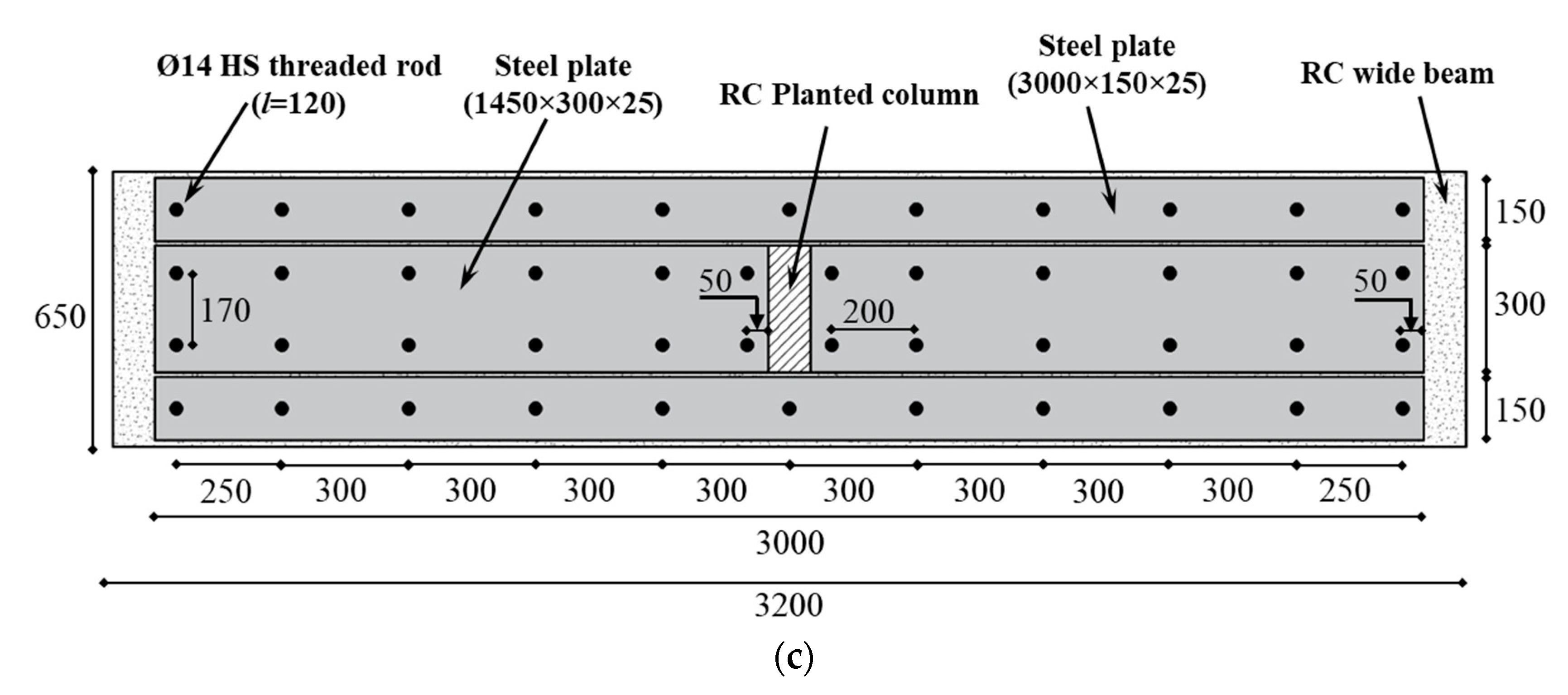


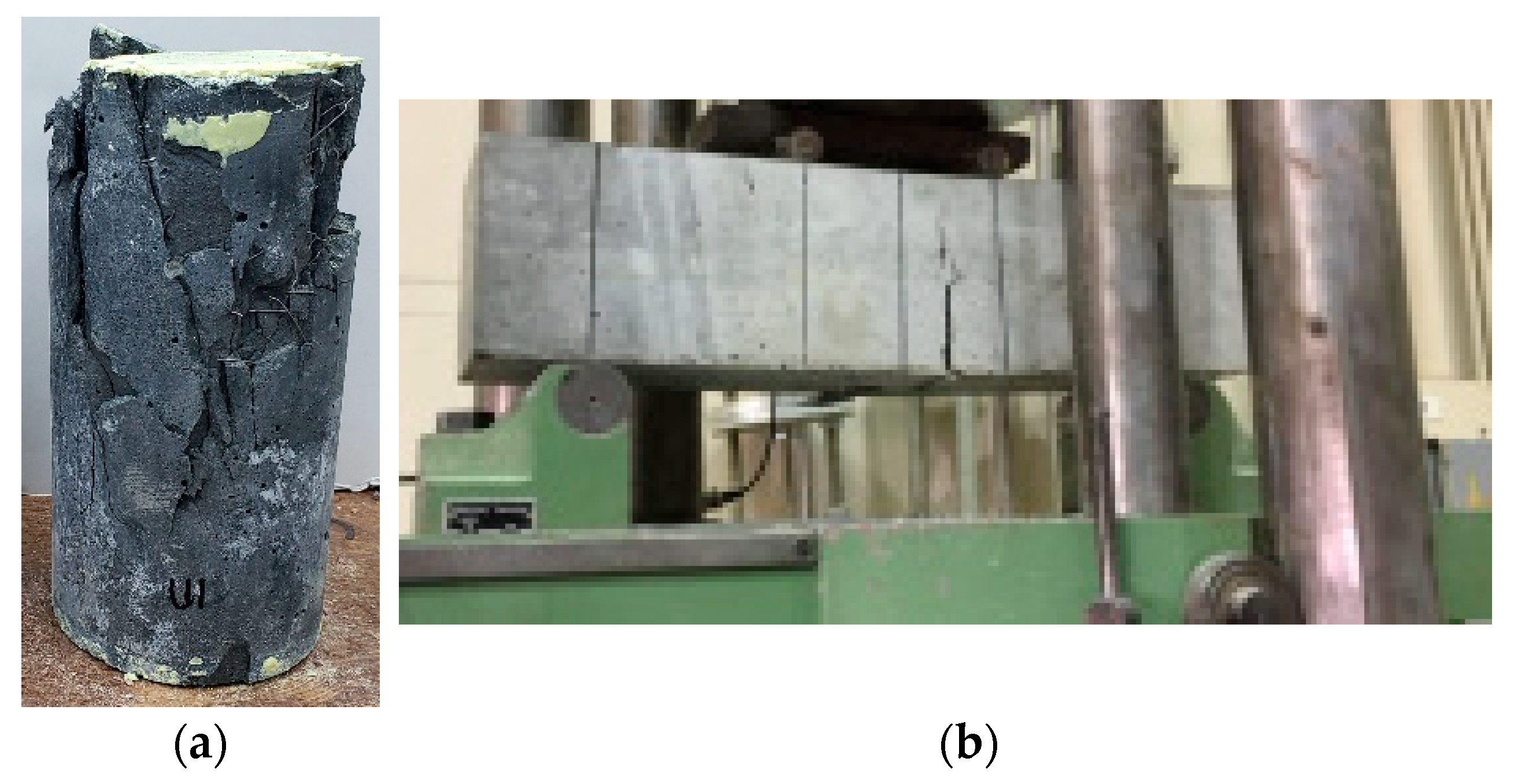
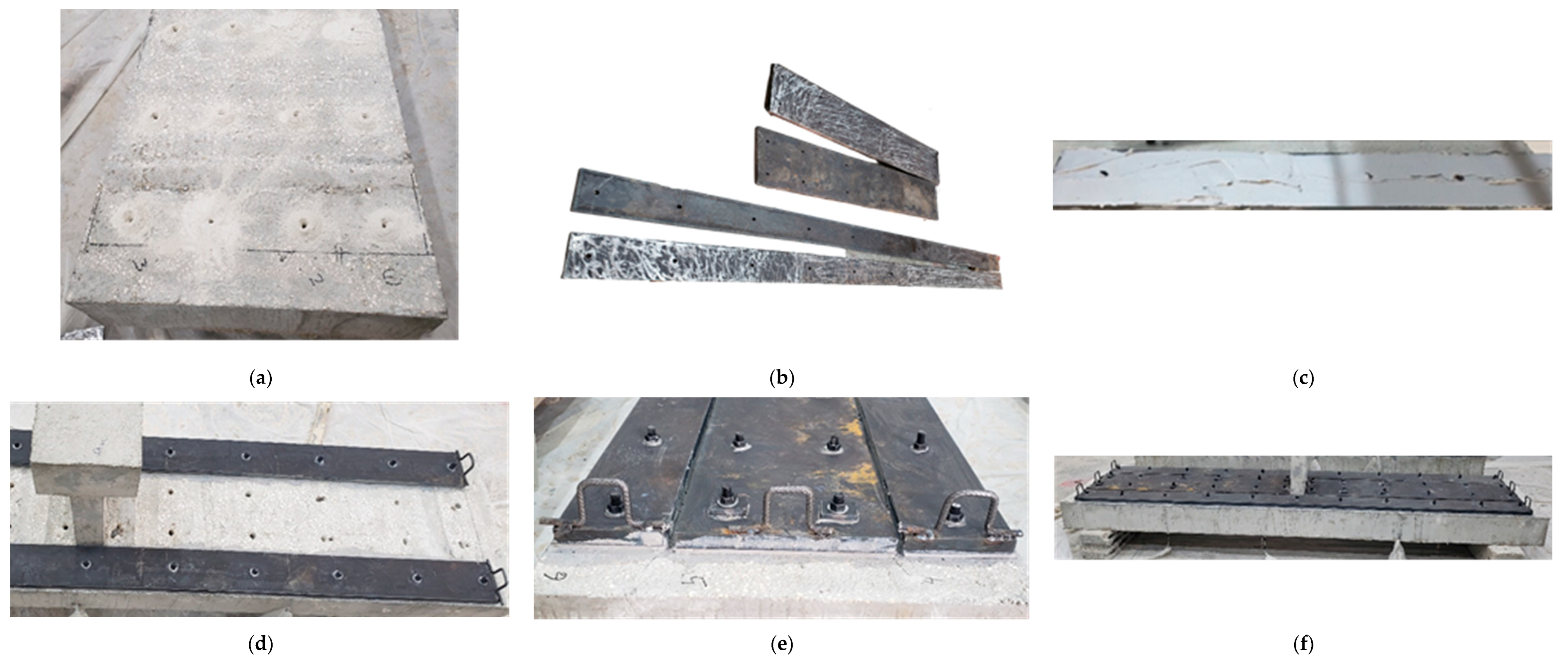
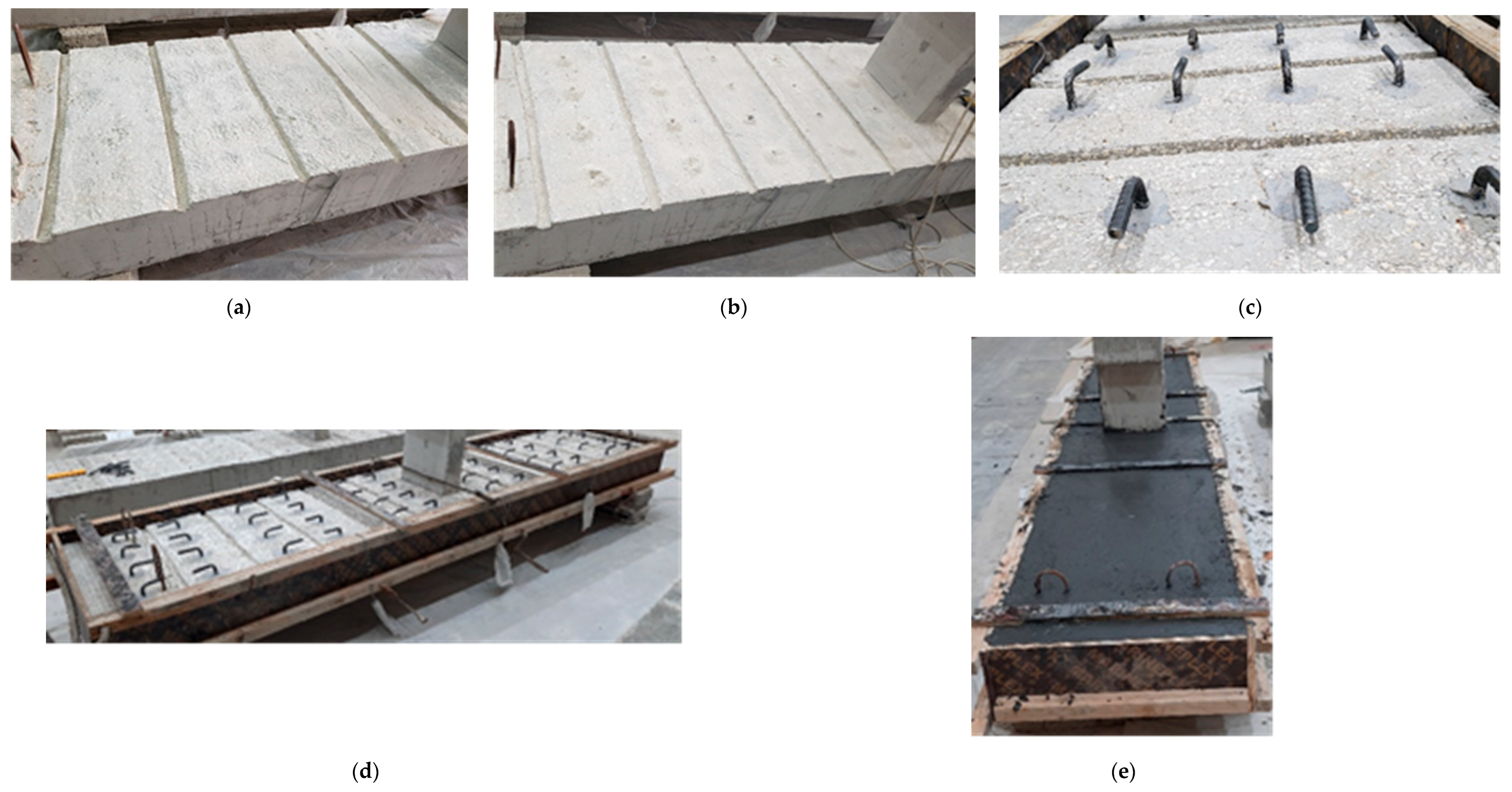
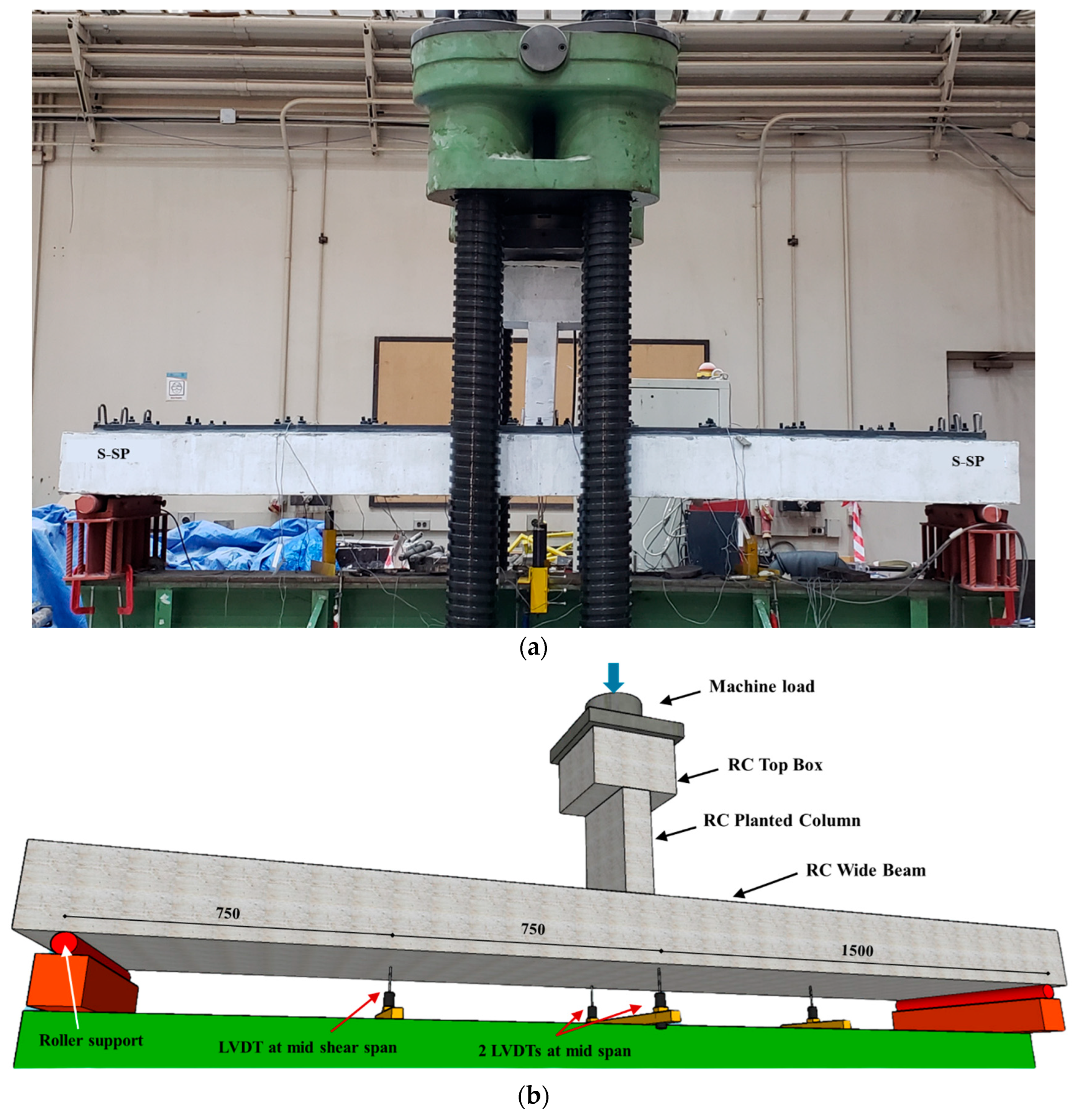




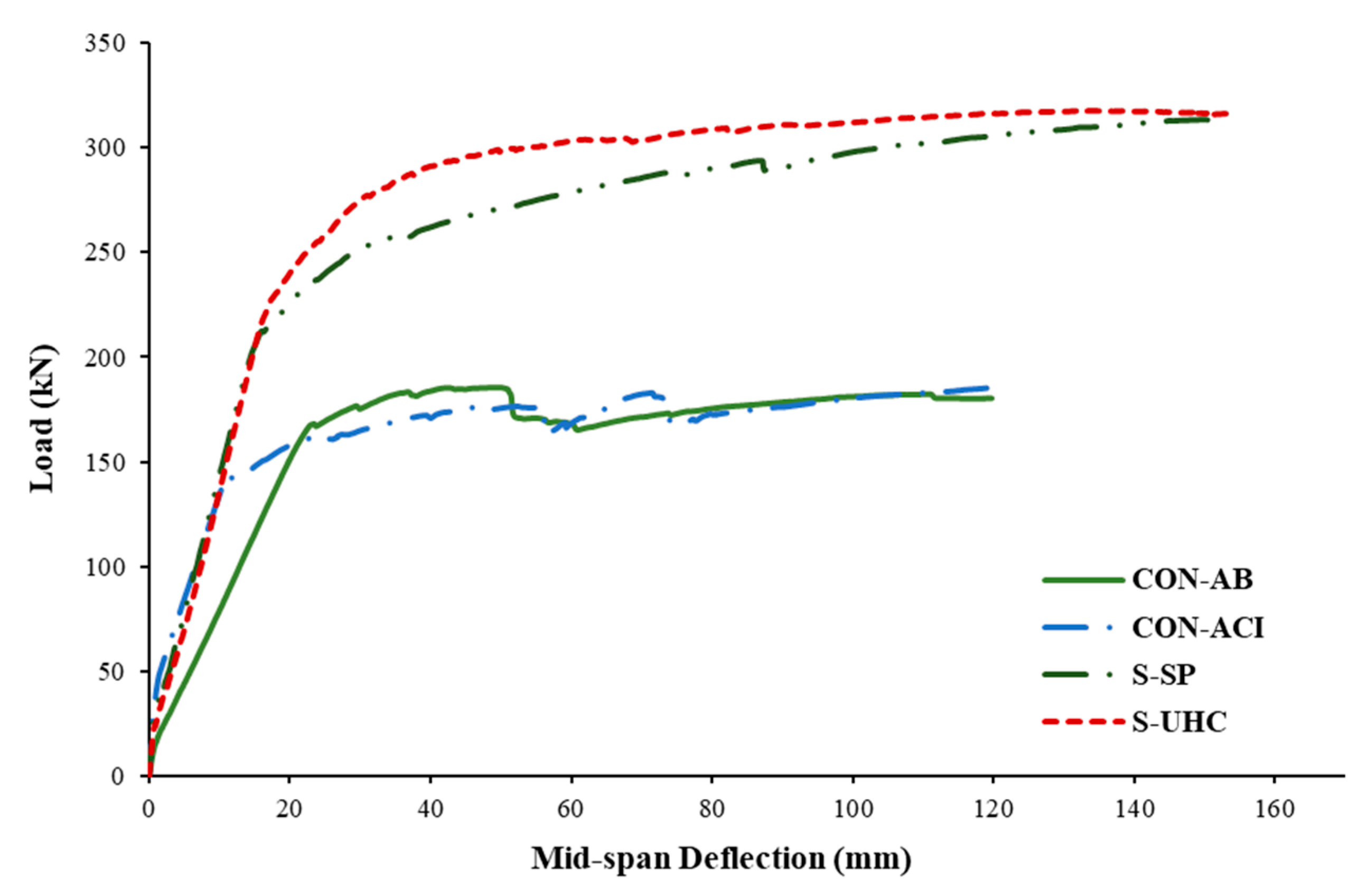



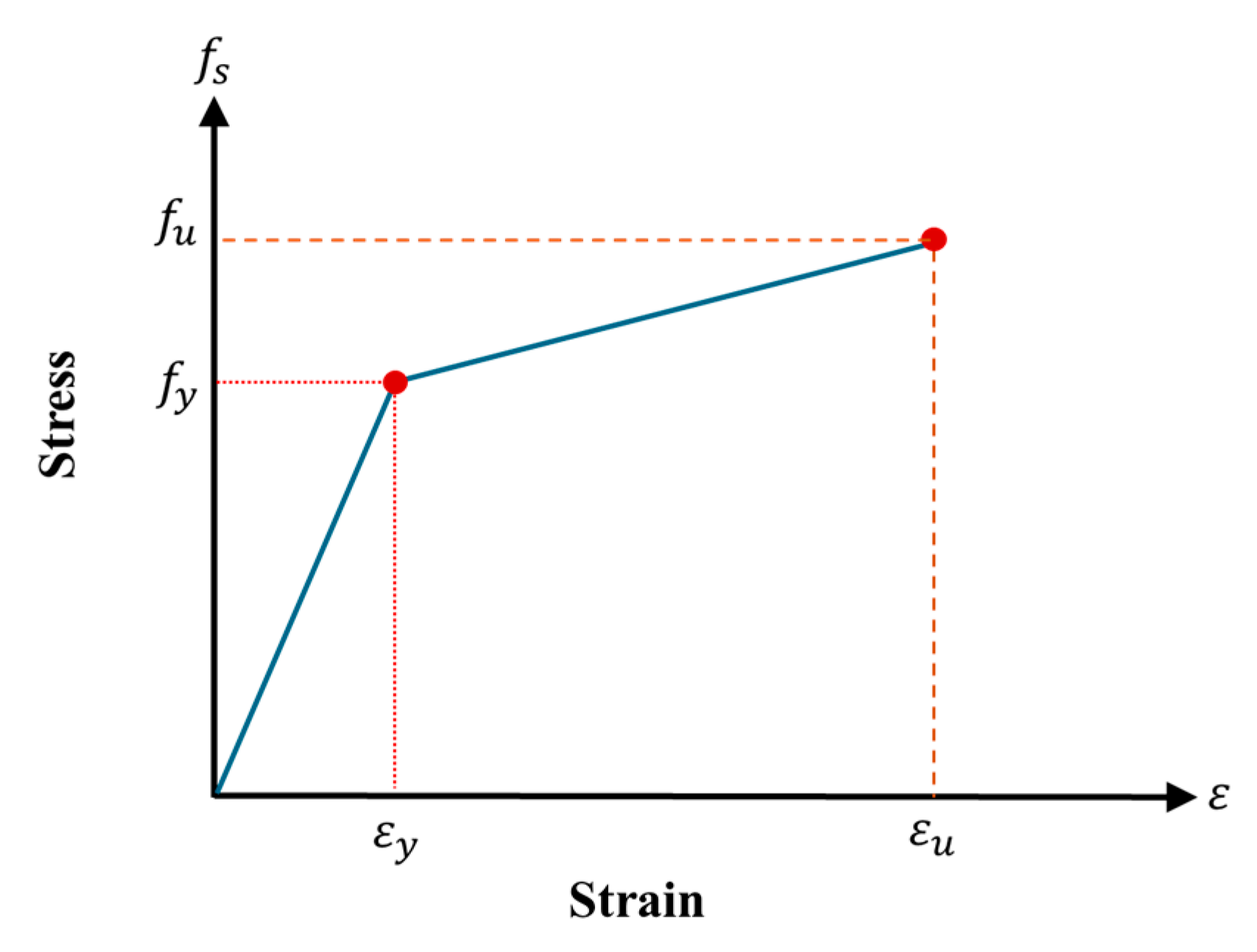
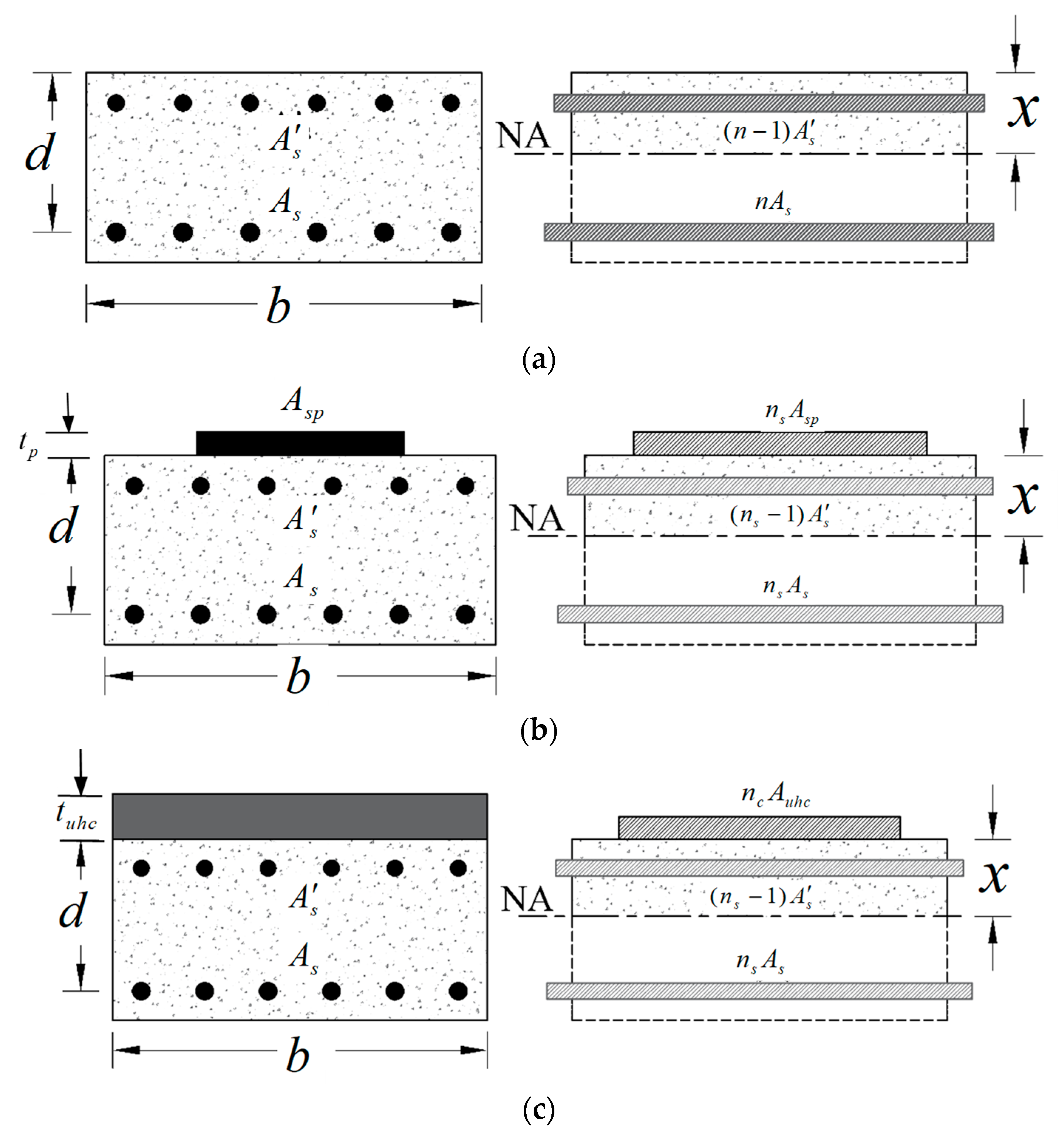
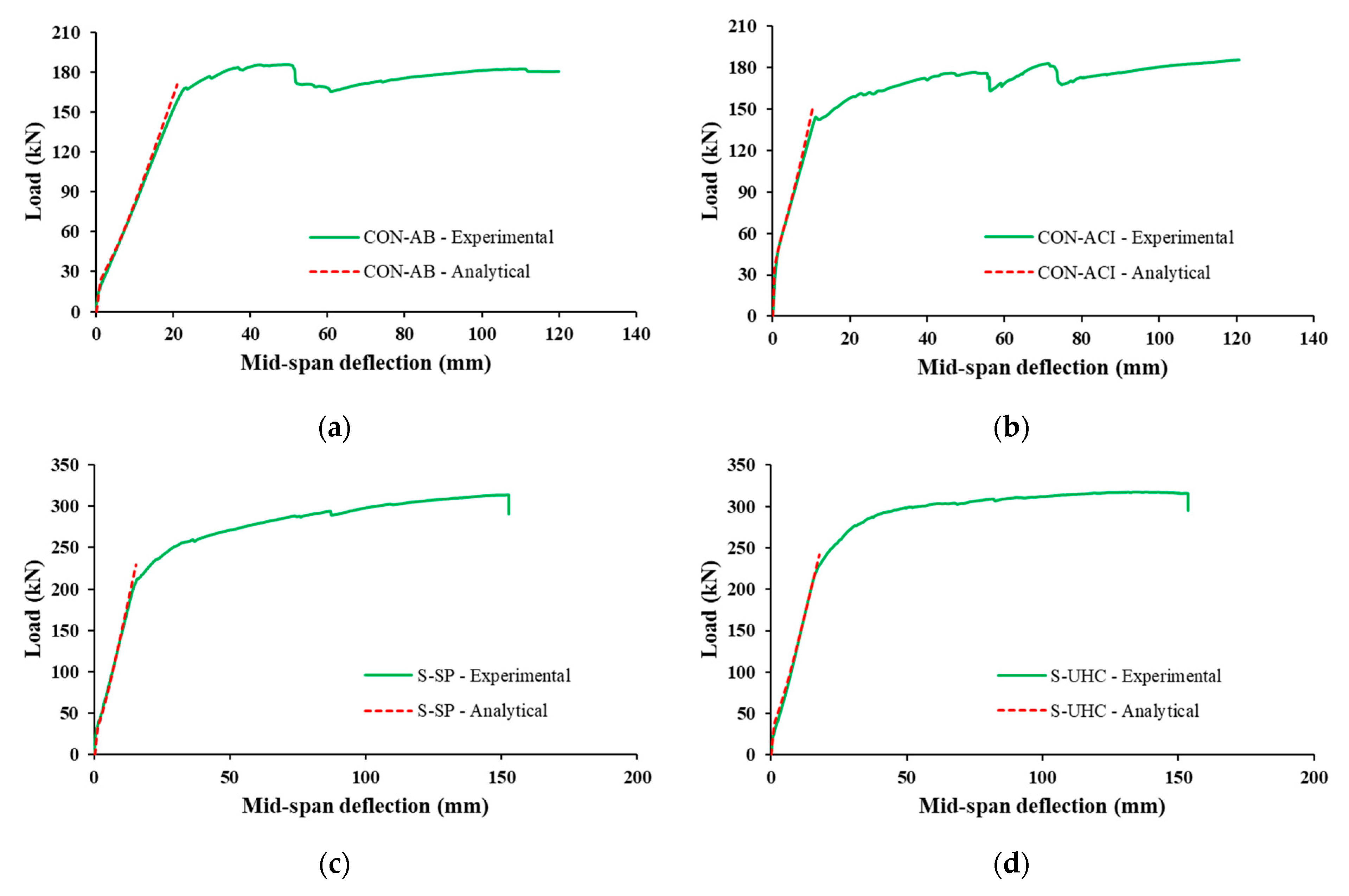
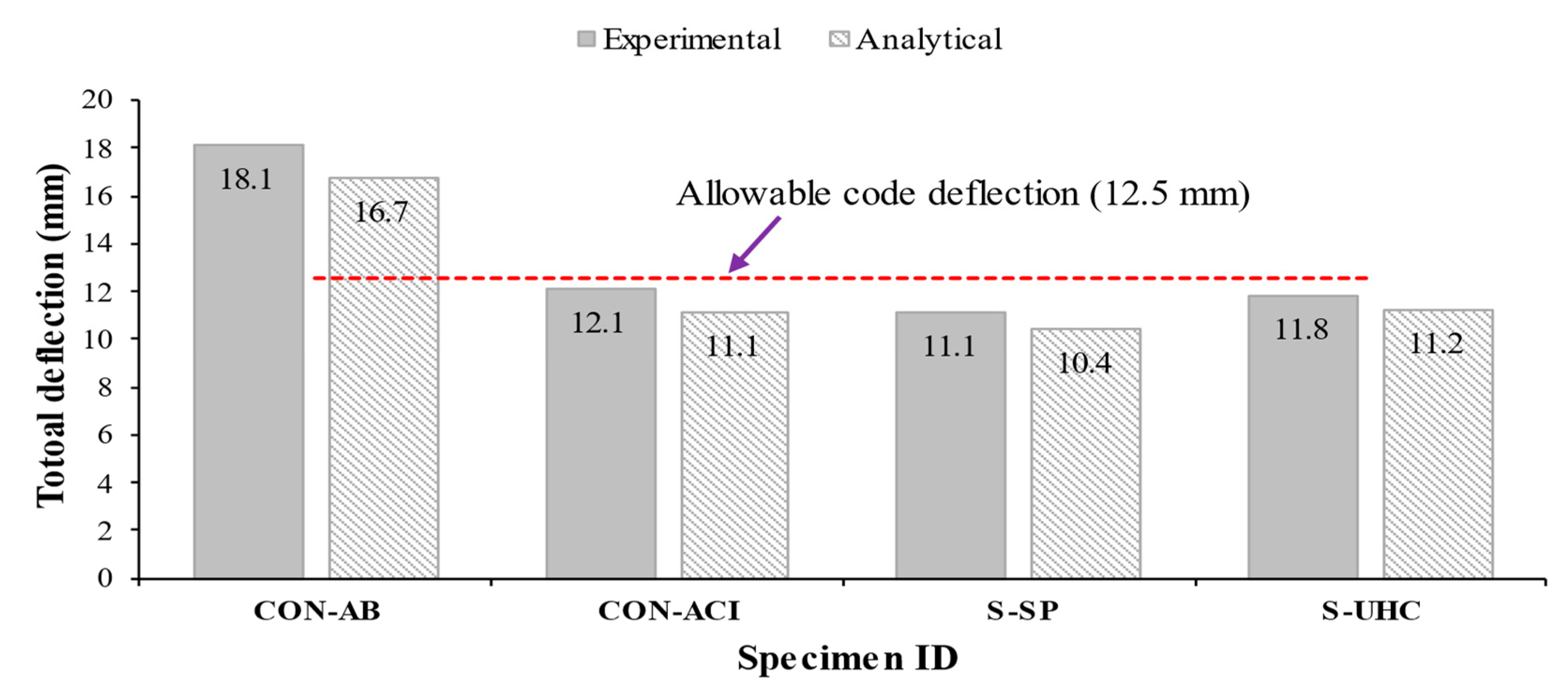
| Specimen ID | Details |
|---|---|
| CON-AB |
|
| CON-ACI |
|
| S-SP |
|
| S-UHC |
|
| Specimen | δD (mm) | δD+L (mm) | δL (mm) | δD+SL (mm) | δtotal = δL + λδD+SL (mm) | Check Deflection (Allowable = 12.5 mm) |
|---|---|---|---|---|---|---|
| CON-AB | 9.3 | 13.4 | 4.1 | 10.4 | 16.7 | Exceeds |
| CON-ACI | 5.9 | 8.5 | 2.6 | 6.6 | 11.1 | Satisfies |
| S-SP | 5.7 | 8.3 | 2.5 | 6.4 | 10.4 | Satisfies |
| S-UHC | 6.3 | 9.0 | 2.7 | 7.0 | 11.2 | Satisfies |
| Parameter | Properties |
|---|---|
| Concrete | |
| Compressive strength on testing day | 40 MPa |
| UHPFRC | |
| Compressive strength on testing day | 120 MPa |
| Flexural strength | 19.5 MPa |
| Steel Rebars | |
| Diameter (mm) | Yield (ultimate) strength (MPa) |
| 8 | 525 (537) |
| 10 | 547 (572) |
| 12 | 550 (657) |
| 18 | 528 (658) |
| Steel Plate | |
| Elastic modulus (MPa) | 200,000 MPa |
| Yield (ultimate) strength (MPa) | 330 (492) |
| Polymer Adhesive Mortar * | |
| Compressive (tensile) strength (MPa) | 52 (13) MPa |
| Elastic modulus | 2600 MPa |
| Bond strength to concrete | >4 MPa |
| Material | Value |
|---|---|
| Cement OPC (kg/m3) | 900 |
| Sand (kg/m3) | 990 |
| Water (kg/m3) | 195 |
| Micro-silica (kg/m3) | 222 |
| Super plasticizer: Master Glenium 51 (kg/m3) | 26 |
| Hooked end steel fibers 1% (kg/m3) | 79 |
| Water to binder ratio | 0.22 |
| Specimen ID | Pcr (kN) | Δcr (mm) | Py (kN) | Δy (mm) | Pu (kN) | Δpu (mm) | kun (kN/mm) | ks (kN/mm) | kpo (kN/mm) | Eu (kN.m) | μΔ | Mode of Failure |
|---|---|---|---|---|---|---|---|---|---|---|---|---|
| CON-AB | 21.4 | 1.6 | 140.7 | 18.5 | 185.4 | 49.6 | 13.4 | 7.6 | 7.1 | 19.2 | 6.5 | FY-C |
| CON-ACI | 54.9 | 2.0 | 137.7 | 10.3 | 185.3 | 71.4 | 27.3 | 13.3 | 10.0 | 19.9 | 11.7 | FY-C |
| S-SP | 38.8 | 1.5 | 173.0 | 12.2 | 313.5 | 152.7 | 25.7 | 14.2 | 12.6 | 40.9 | 12.5 | FY |
| S-UHC | 25.9 | 1.0 | 189.0 | 13.8 | 317.4 | 134.1 | 26.0 | 13.7 | 12.7 | 43.4 | 11.2 | FY-UC |
| Specimen ID | Pu,Exp (kN) | Pu,Anl (kN) | Pu,Exp/Pu,Anl | ks,Exp (kN/mm) | ks,Anl (kN/mm) | ks,Exp/ks,Anl | Δt,Exp (mm) | Δt,Anl (mm) | Δt,Exp/Δt,Anl |
|---|---|---|---|---|---|---|---|---|---|
| CON-AB | 185.4 | 173.3 | 1.07 | 7.6 | 8.1 | 0.94 | 18.1 | 16.7 | 1.08 |
| CON-ACI | 185.3 | 194.5 | 0.95 | 13.3 | 14.6 | 0.91 | 12.1 | 11.1 | 1.08 |
| S-SP | 313.5 | 305.3 | 1.03 | 14.2 | 14.8 | 1.96 | 11.1 | 10.4 | 1.07 |
| S-UHC | 317.4 | 301.3 | 1.05 | 13.7 | 13.7 | 1.00 | 11.8 | 11.2 | 1.05 |
Disclaimer/Publisher’s Note: The statements, opinions and data contained in all publications are solely those of the individual author(s) and contributor(s) and not of MDPI and/or the editor(s). MDPI and/or the editor(s) disclaim responsibility for any injury to people or property resulting from any ideas, methods, instructions or products referred to in the content. |
© 2025 by the authors. Licensee MDPI, Basel, Switzerland. This article is an open access article distributed under the terms and conditions of the Creative Commons Attribution (CC BY) license (https://creativecommons.org/licenses/by/4.0/).
Share and Cite
Elsanadedy, H.; Baatiah, A.; Abadel, A.; Abbas, H.; Almusallam, T.; Al-Salloum, Y. Polymer-Bonded/Bolted Steel Plates Versus UHPFRC Overlay for Controlling Deflection in RC Shallow Beams with Planted Columns—Experimental Insights. Polymers 2025, 17, 3051. https://doi.org/10.3390/polym17223051
Elsanadedy H, Baatiah A, Abadel A, Abbas H, Almusallam T, Al-Salloum Y. Polymer-Bonded/Bolted Steel Plates Versus UHPFRC Overlay for Controlling Deflection in RC Shallow Beams with Planted Columns—Experimental Insights. Polymers. 2025; 17(22):3051. https://doi.org/10.3390/polym17223051
Chicago/Turabian StyleElsanadedy, Hussein, Abdulaziz Baatiah, Aref Abadel, Husain Abbas, Tarek Almusallam, and Yousef Al-Salloum. 2025. "Polymer-Bonded/Bolted Steel Plates Versus UHPFRC Overlay for Controlling Deflection in RC Shallow Beams with Planted Columns—Experimental Insights" Polymers 17, no. 22: 3051. https://doi.org/10.3390/polym17223051
APA StyleElsanadedy, H., Baatiah, A., Abadel, A., Abbas, H., Almusallam, T., & Al-Salloum, Y. (2025). Polymer-Bonded/Bolted Steel Plates Versus UHPFRC Overlay for Controlling Deflection in RC Shallow Beams with Planted Columns—Experimental Insights. Polymers, 17(22), 3051. https://doi.org/10.3390/polym17223051






